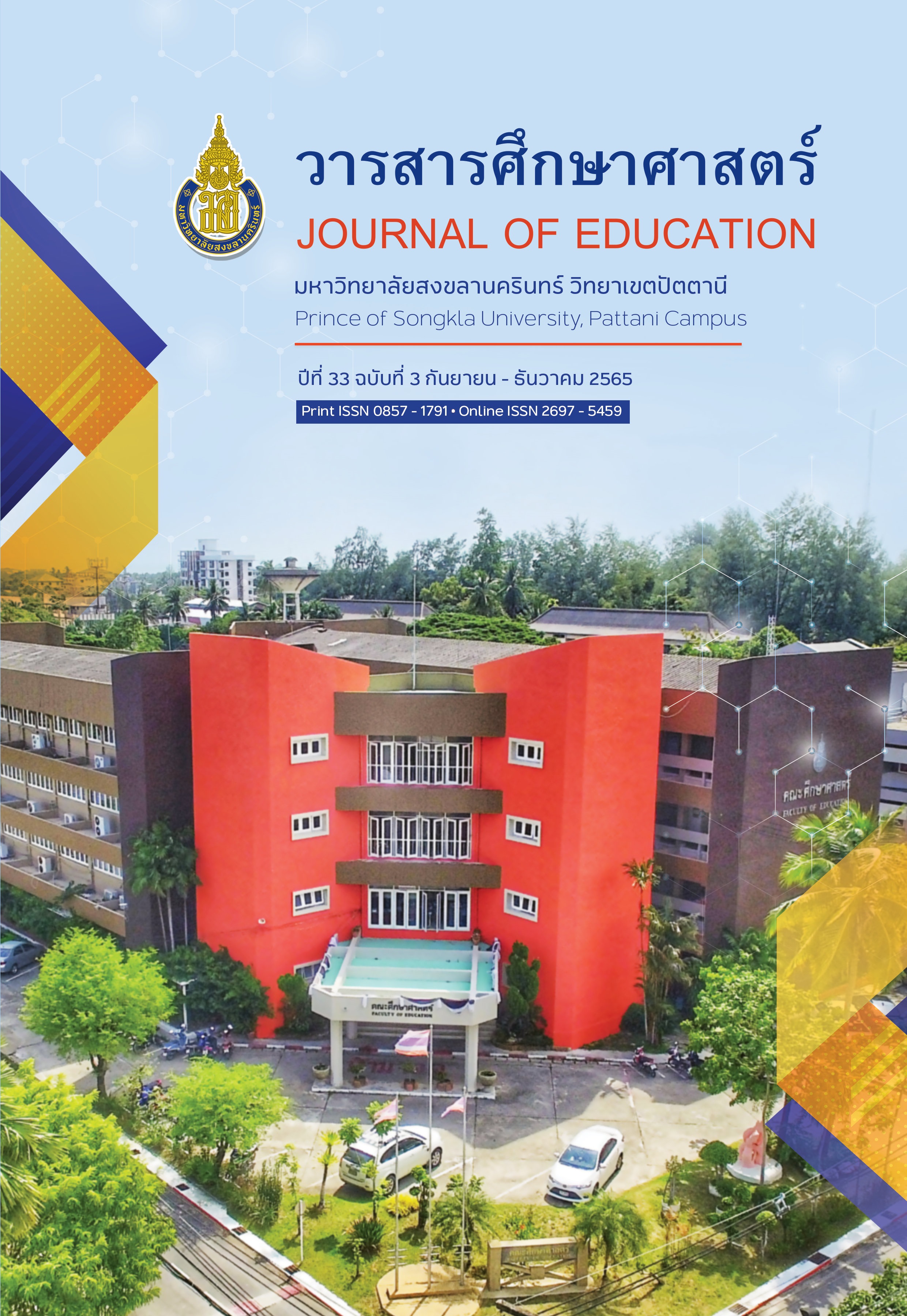การเปรียบเทียบความแตกต่างของกระบวนการตัดสินใจเลือกใช้บริการศูนย์ออกกำลังกายมหาวิทยาลัยในกำกับของรัฐ ระหว่างนักศึกษาเพศชายและเพศหญิง
Main Article Content
บทคัดย่อ
การศึกษาครั้งนี้มีวัตถุประสงค์เพื่อเปรียบเทียบความแตกต่างของกระบวนการตัดสินใจเลือกใช้บริการศูนย์ออกกำลังกายมหาวิทยาลัยในกำกับของรัฐ ระหว่างนักศึกษาเพศชายและเพศหญิง การวิจัยนี้เป็นวิจัยเชิงปริมาณ เครื่องมือที่ใช้ในการวิจัยเป็นแบบสอบถามกระบวนการตัดสินใจเข้าใช้บริการศูนย์ออกกำลังกายมหาวิทยาลัยในกำกับของรัฐที่ผู้วิจัยสร้างขึ้น มีค่าความเชื่อมั่นของแบบสอบถาม 0.97 ใช้ตัวอย่างทั้งหมด 938 ตัวอย่าง เป็นชาย 479 คน หญิง 459 คน โดยใช้วิธีการสุ่มแบบหลายขั้นตอน วิเคราะห์ค่าร้อยละ ค่าเฉลี่ย
ค่าส่วนเบี่ยงเบนมาตรฐาน และการทดสอบความแตกต่างแบบกลุ่มอิสระด้วยสถิติ t-test
ผลการวิจัยพบว่า ตัวแปรที่มีอิทธิพลมากที่สุดต่อกระบวนการตัดสินใจในขั้นก่อนการซื้อของนักศึกษาชายและหญิงในการเลือกใช้บริการศูนย์ออกกำลังกายมหาวิทยาลัยในกำกับของรัฐ คือ การรับรู้ปัญหาและความต้องการทางสังคมด้านกระแสความนิยม การรับรู้ปัญหาและความต้องการทางกายด้านความต้องการให้ร่างกายแข็งแรงสุขภาพดี การค้นหาข้อมูลด้านสื่อบุคคล การประเมินทางเลือกด้านคุณสมบัติสินค้าและด้านทัศนคติในส่วนขั้นการซื้อตัวแปรที่มีอิทธิพลมากที่สุด คือ ส่วนประสมการตลาดด้านลักษณะทางกายภาพ คุณภาพการให้บริการด้านรูปธรรมการบริการและด้านความเชื่อมั่นต่อลูกค้า ขณะที่ขั้นหลังการซื้อ ตัวแปรที่มีอิทธิพลมากที่สุด คือ การกลับมาใช้บริการด้านการยึดติดสินค้า และความพึงพอใจด้านความคาดหวังของผู้บริโภค ความแตกต่างของกระบวนการตัดสินใจเลือกใช้บริการศูนย์ออกกำลังกายมหาวิทยาลัยในกำกับของรัฐ ระหว่างนักศึกษาชายและหญิง มีความแตกต่างกันอย่างมีนัยสำคัญทางสถิติที่ .05 ใน 2 ขั้น ประกอบด้วย ขั้นที่ 1 ขั้นก่อนการซื้อ เกี่ยวกับด้านการค้นหาข้อมูล ด้านการประเมินทางเลือก และขั้นที่ 2 ขั้นการซื้อ เกี่ยวกับด้านส่วนประสมการตลาด และด้านคุณภาพการให้บริการ อย่างไรก็ตาม ด้านการรับรู้ปัญหาและความต้องการที่เป็นตัวแปรในขั้นที่ 1 ขั้นก่อนการซื้อ และขั้นหลังการซื้อไม่มีความแตกต่างกันระหว่างนักศึกษาเพศชายและเพศหญิง เกี่ยวกับด้านการกลับมาใช้บริการ และด้านความพึงพอใจ
Article Details

อนุญาตภายใต้เงื่อนไข Creative Commons Attribution-NonCommercial 4.0 International License.
เอกสารอ้างอิง
Chaphromma, C. (2017). Factors Influencing Decision to Use Fitness Services Center open 24 hours for consumers in Bangkok. Independent research. Faculty of Commerce and Accountancy: Thammasat University. (in Thai)
Chindarueang, C. (2012). Model of quality management of fitness centers of Rajabhat University in Thailand. (Doctor thesis). Sports and Entertainment Business College of Graduate Studies in Management: Sripatum University. (in Thai)
Chinwon, A. (2010). Public relations media. Bangkok: Chulalongkorn University Press. (in Thai)
Chuacharoen, O., Siritharang si, P. & Chunha si wong, K. (2019). Factors Affecting the Management of Fitness Business in the Lad Krabang Area. Journal of Development Administration Research, 9(1). (in Thai)
Henkel, D., Houchaime, N., Locatelli, N., Singh, S., Zeithaml, V. A., & Bittner, M. J. (2006). The impact of emerging wlans on incumbent cellular service providers in the u.s. m.j. services marketing. Singapore: McGraw-Hill.
Inthuphut, N. (2016). Factors affecting the use of health centers (Fitness Center) of people in Wattana District, Bangkok. The 7th National and International Academic Conference and Research Presentation, 25 March 2016, Bangkok: Suan Sunandha Rajabhat University. (in Thai)
Ketsophasrit, S. (2015). Factors of Correlation and Positive Influence on Intention to Loyalty. In the use of fitness center services for consumers in the Bangkok area (Master thesis). Bangkok: Bangkok University. (in Thai)
Khongthaen, C. (2017). The decision to use the fitness center in Bangkapi district. Ramkhamhaeng Economic Journal. Year 3 No. 1 (273-286). (in Thai)
Kotler, P. (1997). Marketing Management: Analysis, Planning, Implementation and Control (14th Global ed.). Upper Saddle River, NJ: Prentice-Hall.
Kotler, P., & Keller, K.L. (2012). Marketing management (14 th ed.). Upper Saddle River, New Jersey: Prentice-Hall.
Kotler, P. (2016). Marketing Management: Analysis, Planning, Implementation and Control (15th Global ed.). Upper Saddle River, NJ: Prentice-Hall.
Krittiyawan, S. & Chaiwanwat, S. (2019). Exercise behavior of students Faculty of Nursing Ratchathani University. The 4th National Academic Conference and Presentation of Ratchathani Academic Research, 31 May 2019. Ubon Ratchathani: Ratchathani University. (in Thai)
Li, X., & Petrick, J. F. (2010). Towards an integrative model of loyalty formation: The role of quality and value. Leisure Sciences, 32 (3), 201–221.
Lin, Y. C., Tsai, H. N., & Lee, Y. C. (2020). The effects of product categories, brand alliance fitness and personality traits on customer’s brand attitude and purchase intentions: A case of Spotify. Journal of Statistics and Management Systems, 23(3), 677-693.
Livia Vania Suwono, Sabrina Oktaria Sihombing. (2016). Factors Affecting Customer Loyalty of Fitness Centers : An Empirical Study Jurnal Dinamika Manajemen, 7 (1), 45-55. http://jdm.unnes.ac.id
Serirat, S. (1995). Consumer behavior. Bangkok: Thai Wattana Panich. [in Thai]
Serirat, S. (2003). Marketing management. Bangkok: Development Studies. [in Thai]
Vieira, E. R. M., & Ferreira, J. J. (2018). Strategic framework of fitness clubs based on quality dimensions: the blue ocean strategy approach. Total Quality Management & Business Excellence, 29 (13-14), 1648-1667.
Yu, Hyun soon, James J.Zhang, Dae Hyun Kim, Kenny K.Chen, Chris Henderson, and Sophia D.Min Haiyan Huang. (2014). Service Quality, Perceived Value, Customer Satisfaction, and Behavioral Intention Among Fitness CenterMembers Aged 60 Years and Over, Social Behavior and Personality. 42(5), 757-768
Yu ma din, F. & Kaeo khiao, K. (2019). Marketing Mix, Service, and Service Quality Affecting Decision-Making Behavior of Fitness Center Services in Muang District, Chumphon Province. Electronic Journal of Innovative Distance Learning, 9(2), 53-64. (in Thai)


